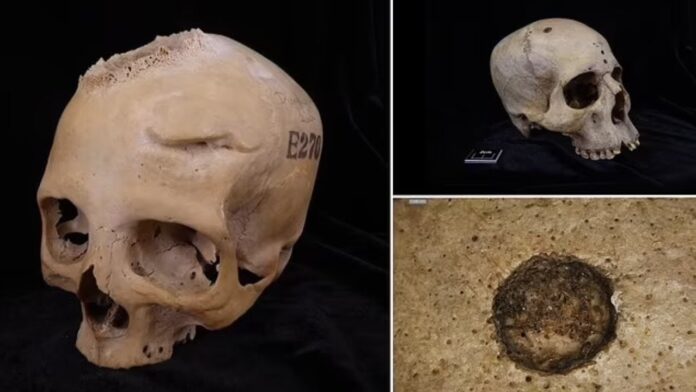The discovery of cutmarks around cancerous growths on ancient Egyptian skulls provides unique insights into early attempts at cancer care
Scientists recently discovered cutmarks around cancerous growths on an ancient Egyptian skull, revealing new insights into how ancient Egyptians may have tried to treat cancer. This finding provides unique evidence of surgical interventions related to cancer thousands of years ago. Ancient Egyptians were known for their advanced medical knowledge, but this discovery shows their attempts to understand and treat cancer.
An international team of researchers studied two human skulls, each thousands of years old, to explore the limits of ancient Egyptian traumatological and oncological treatments. Skull and mandible 236, dating from between 2687 and 2345 BCE, belonged to a male individual aged 30 to 35. Researchers found a large lesion consistent with excessive tissue destruction, known as a neoplasm, and 30 or so small metastasized lesions scattered across the skull.
Microscopic analysis revealed cutmarks around these lesions, probably made with a sharp object like a metal instrument. “When we first observed the cutmarks under the microscope, we could not believe what was in front of us,” said Tatiana Tondini, a researcher at the University of Tübingen and first author of the study published in the journal Frontiers in Medicine.
These cut marks suggest that ancient Egyptians performed some kind of surgical intervention related to the presence of cancerous cells. “This finding is unique evidence of how ancient Egyptian medicine tried to deal with or explore cancer more than 4,000 years ago,” said Prof Edgard Camarós, a paleopathologist at the University of Santiago de Compostela.
The researchers examined the skulls using microscopic analysis and CT scanning. Skull E270, dating from between 663 and 343 BCE, belonged to a female individual who was older than 50 years. This skull also showed a large lesion consistent with a cancerous tumour that led to bone destruction. This indicates that cancer was a common pathology in the past, despite today’s lifestyle factors that increase cancer risk.
Skull E270 also displayed two healed lesions from traumatic injuries. One of these injuries likely originated from a close-range violent event using a sharp weapon. The healed lesions suggest that the individual received some form of treatment and survived. Seeing such a wound on a female individual is uncommon, as most violence-related injuries are found in males. “Was this female individual involved in warfare activities?” asked Tondini. “If so, we must rethink the role of women in the past and how they took an active part in conflicts during antiquity.”
The study highlights the challenges of working with skeletal remains, as remains are often incomplete and lack known clinical history. “In archaeology, we work with a fragmented portion of the past, complicating an accurate approach,” noted Prof Albert Isidro, a surgical oncologist and co-author of the study.
Despite these challenges, the study contributes to a changing perspective on ancient medical practices and sets a foundation for future research in paleo-oncology. “This study sets an encouraging base for future research on how ancient societies dealt with cancer,” concluded Camarós.
The researchers emphasized the need for more studies to fully understand how ancient societies interacted with and treated cancer. The discovery of cutmarks on these ancient skulls opens a new chapter in the history of medicine, shedding light on the early attempts to understand and manage cancer.
Analysis:
The discovery of ancient Egyptian skulls with cutmarks around cancerous growths offers significant insights into early medical practices and societal attitudes towards disease. Politically, this discovery underscores the advanced nature of ancient Egyptian society, which invested considerable effort in medical knowledge and practice. The presence of surgical attempts on cancerous lesions indicates that there was a systematic approach to medical treatment, even if the understanding of cancer was limited.
Sociologically, the findings highlight the complexity of ancient Egyptian society. The presence of healed traumatic injuries on a female skull suggests that women may have had roles in activities typically associated with men, such as warfare. This challenges traditional perceptions of gender roles in ancient societies and suggests a more nuanced understanding of women’s participation in various aspects of life, including conflict.
Economically, the effort to perform surgical interventions on cancerous lesions indicates that resources were allocated towards healthcare, even for complex and poorly understood conditions like cancer. This suggests that there was a recognized value in attempting to treat and manage diseases, which could reflect broader societal priorities regarding health and well-being.
Locally, the discovery provides a glimpse into the medical practices of ancient Egyptians, particularly in how they dealt with diseases that were prevalent at the time. The fact that these skulls were found in Egypt highlights the region’s long history of medical knowledge and experimentation, contributing to our understanding of local historical practices.
From a gender perspective, the presence of healed traumatic injuries on a female skull invites a reevaluation of women’s roles in ancient societies. It suggests that women may have been more actively involved in activities such as defence or conflict than previously thought. This finding adds depth to our understanding of gender dynamics in ancient Egypt.
In terms of race and minority perspectives, the discovery underscores the universal nature of diseases like cancer and the commonality of medical challenges across different societies and time periods. The attempt to treat cancer in ancient Egypt reflects a shared human experience of grappling with illness and seeking ways to alleviate suffering.
Overall, the discovery of cutmarks on ancient Egyptian skulls associated with cancerous lesions provides valuable insights into the history of medicine, societal structures, and the role of gender in ancient societies. It highlights the advanced nature of ancient Egyptian medical practices and opens new avenues for research into the treatment of diseases in antiquity.
